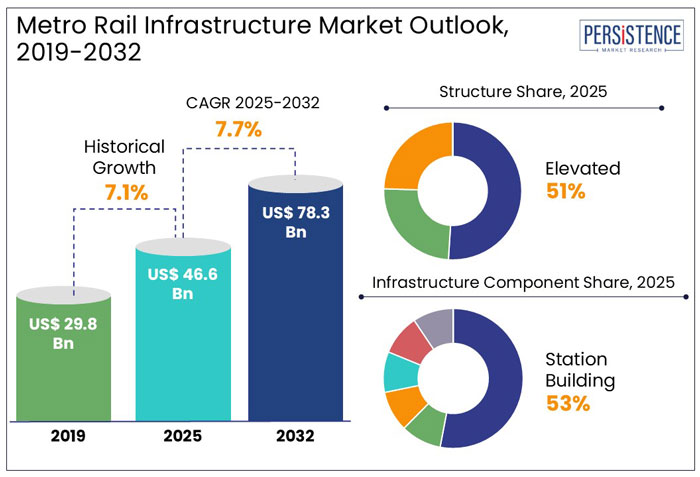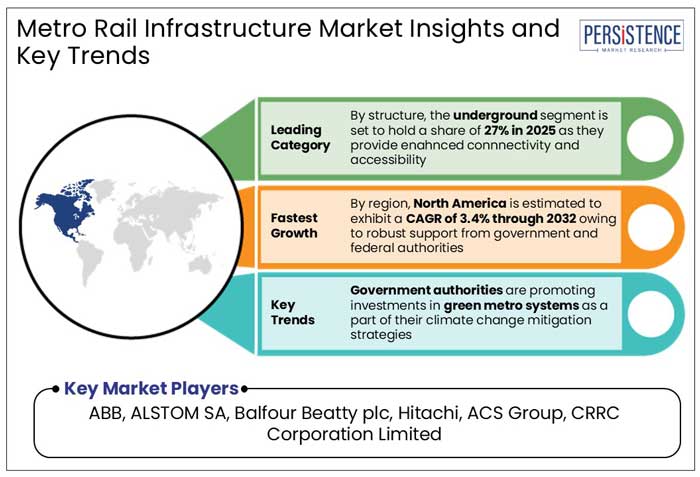Industry: Automotive & Transportation
Published Date: February-2025
Format: PPT*, PDF, EXCEL
Delivery Timelines: Contact Sales
Number of Pages: 182
Report ID: PMRREP35120
The global metro rail infrastructure market is predicted to reach a size of US$ 46.6 Bn by 2025. It is anticipated to witness a CAGR of 7.7% during the forecast period to attain a value of US$ 78.3 Bn by 2032.
Rapid migration to urban centers has created a pressing demand for efficient and reliable mass transit systems. The UN estimates that 68% of the global population will live in urban areas by 2050, driving investments in metro rail infrastructure.
Adoption of driverless trains, automated fare collection systems, and AI-based monitoring systems are making metro rails effective and cost-efficient. Introduction of 5G and IoT in metro operations enables predictive maintenance and real-time passenger information systems. By 2030, 30% of metro rail systems are predicted to be fully automated.

Key Highlights of the Industry
|
Market Attributes |
Key Insights |
|
Metro Rail Infrastructure Market Size (2025E) |
US$ 46.6 Bn |
|
Projected Market Value (2032F) |
US$ 78.3 Bn |
|
Global Market Growth Rate (CAGR 2025 to 2032) |
7.7% |
|
Historical Market Growth Rate (CAGR 2019 to 2023) |
7.1% |
North America metro rail infrastructure market is estimated to hold a share of 36% in 2025. Prominent cities in the region, including New York City, Los Angeles, Chicago, and San Francisco, are undergoing massive upgrades to their metro rail systems. For example,
Metro systems in North America are early adopters of novel technologies, including driverless trains, automated ticketing, and real-time passenger information systems. Implementation of 5G and IoT-based smart rail technologies is predicted to enhance operational efficiency.
Elevated structure is projected to hold a share of 51% in 2025. Elevated metro structures are generally more cost-effective than underground systems, as they avoid extensive excavation and tunnelling. Construction of elevated metro lines costs 30% to 50% less compared to underground metro systems. For example,
Elevated metro systems optimize land usage by utilizing airspace above roads and highways. Cities like Bangkok, Jakarta, and New Delhi have adopted elevated metro designs to overcome space constraints and minimize land acquisition challenges. Elevated metro lines have a faster construction timeline due to prefabricated components and less disruption to existing urban infrastructure.
Elevated structures avoid the environmental and social impacts of tunneling, such as groundwater disturbances and subsidence risks. Advances in prefabrication and modular construction techniques have improved the efficiency and safety of elevated metro rail projects.
Station building is anticipated to hold a share of 53% in 2025. Governments and metro authorities are increasingly focusing on enhancing passenger experience through modern and well-equipped station facilities. Amenities like waiting lounges, clean washrooms, retail spaces, and advanced ticketing systems are becoming essential components in the metro rail infrastructure.
Smart metro stations with advanced technologies like automated fare collection systems, contactless payments, passenger information displays, and real-time analytics, are becoming the norm. Metro stations are evolving in multi-modal hubs, seamlessly integrating metro services with bus networks, bike-sharing schemes, taxis, and ride-hailing services. For example,
Station buildings are increasingly being utilized for retail and commercial purposes to offset operational costs and provide additional revenue streams. Rapid urbanization and increasing metro ridership demand larger and more sophisticated station buildings to accommodate growing passenger volumes.
Potential growth in the global metro rail infrastructure industry is predicted to be driven by public-private partnerships projects in India and Brazil, which have seen positive results in infrastructure development. Modernization of existing networks and infrastructure expansion in cities in North America is likely to spur growth. Government authorities across Europe are focusing on carbon neutrality and sustainable urban mobility, thereby driving metro rail expansion.

The metro rail infrastructure market growth was steady at a CAGR of 7.1% during the historical period. Rapid urbanization during the period resulted in the expansion of metro rail systems in cities worldwide. For instance,
The European Union Green Deal allocated funds for sustainable public transportation, including metro rail infrastructure, aiming for carbon neutrality by 2050. Increased investment in smart signaling systems and digital ticketing platforms contributed to operational efficiency.
The forecast period is likely to witness a rising adoption of smart and automated technologies. The period is predicted to focus on carbon-neutral transportation systems to comply with sustainability goals.
Increasing Smart City Initiatives
Urban mobility is emerging as a critical component of smart city initiatives. Governments and municipalities are investing in metro rail systems to decrease urban congestion and pollution. For instance,
Smart metro rail systems are being integrated with IoT sensors and AI-powered platforms for real-time monitoring, predictive maintenance, and energy optimization.
Smart cities emphasize seamless travel experiences through real-time passenger information systems and digital ticketing platforms.
Rising Demand for Sustainable and Green Infrastructure
Urban transportation accounts for 40% of total urban emissions, making it a primary target for green infrastructure upgrades.
Governments and metro project developers are increasingly pursuing green certifications such as LEED for station buildings and operational systems.
Metro systems are integrating technologies like regenerative braking, LED lighting, and energy-efficient HVAC systems.
Competition from Alternative Transportation Solutions
Passenger preferences are shifting toward more flexible, cost-efficient, and on-demand transport options. Metro systems are typically seen as more rigid in terms of timing, routes, and capacity. Ride-hailing services and shared mobility options, on the other hand, offer greater flexibility and personalized experiences.
Ride-hailing services have become a popular choice for passengers, particularly in cities with underdeveloped metro networks or those experiencing service disruptions in metro systems. Leading ride-hailing companies offer door-to-door services that provide flexibility, thereby making them appealing.
Bike-sharing programs and electric scooters have become increasingly popular for short-distance travel. These services are often seen as more flexible and cheaper compared to metro rides.
Shift toward Multimodal Transport Solutions
As cities grow, congestion and the environmental impact of transportation have driven the need for more efficient and sustainable solutions. In major metropolitan areas, multimodal transport solutions aim to reduce traffic congestion and improve the mobility experience for commuters. Several cities are developing integrated transportation systems where metro networks are linked to other modes of transportation.
Multimodal transport systems enable passengers to easily switch between different modes of transport, optimizing travel routes and reducing overall travel time. New York's MTA has integrated metro, bus, and ferry systems, thereby reducing commuter congestion and enabling more flexible travel options across boroughs.
Increasing Focus on Passenger Comfort and Safety
Passengers today expect comfortable seating, climate control, cleanliness, and adequate space to enhance their daily commute.
Passenger safety is paramount, especially with rising concerns about potential threats like accidents, terrorism, and health-related safety issues. Metro systems are adopting a variety of measures to enhance security. This includes the integration of CCTV surveillance, emergency communication systems, train monitoring, and trained staff.
Companies in the metro rail infrastructure market are investing in the integration of smart technologies to make metro rail systems more efficient, automated, and user-friendly. Technologies like the IoT, AI, and data analytics are being used for predictive maintenance, real-time monitoring, and passenger management.
Several metro manufacturers are adopting driverless trains and automated ticketing systems. This assists in decreasing operational costs and ensuring safer and efficient operations.
Increasing concerns about climate change has led businesses to focus on sustainable development. They are prioritizing green building practices, energy-efficient designs, and carbon footprint reduction.
Organizations are actively expanding metro networks to cover new urban areas, integrating additional lines, and increasing train frequencies to cater to rising demand. Older systems are being modernized to improve reliability, increase capacity, and enhance passenger experience.
Recent Industry Developments
|
Attributes |
Detail |
|
Forecast Period |
2025 to 2032 |
|
Historical Data Available for |
2019 to 2023 |
|
Market Analysis |
US$ Billion for Value |
|
Key Regions Covered |
|
|
Key Market Segments Covered |
|
|
Key Companies Profiled in the Report |
|
|
Report Coverage |
|
|
Customization and Pricing |
Available upon request |
By Structure
By Infrastructure Components
By Region
To know more about delivery timeline for this report Contact Sales

The market is anticipated to reach a value of US$ 78.3 Bn by 2032.
Elevated, underground, and at-grade level are the three main structure types.
North America is anticipated to emerge as the leading region with a share of 36% in 2025.
Prominent players in the market include ACS Group, CRRC Corporation Limited, and Mitsubishi Heavy Industries.
The market is predicted to witness a CAGR of 7.7% throughout the forecast period.